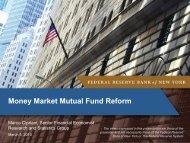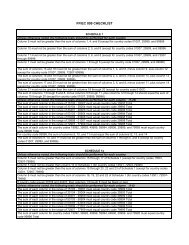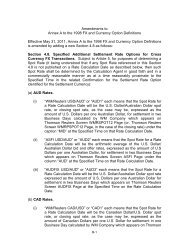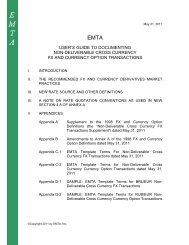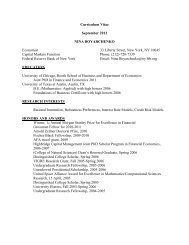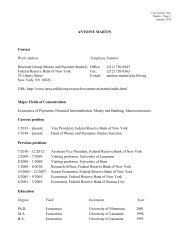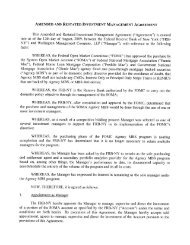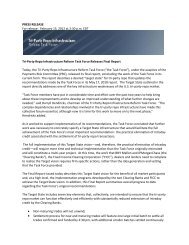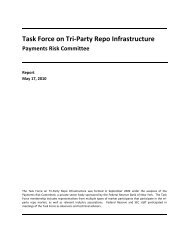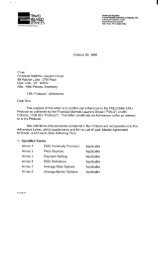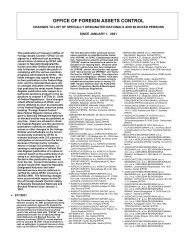Residential Foreclosures in the City of Buffalo, 1990-2000 - Federal ...
Residential Foreclosures in the City of Buffalo, 1990-2000 - Federal ...
Residential Foreclosures in the City of Buffalo, 1990-2000 - Federal ...
You also want an ePaper? Increase the reach of your titles
YUMPU automatically turns print PDFs into web optimized ePapers that Google loves.
<strong>in</strong>ord<strong>in</strong>ately high loan amounts, and correspond<strong>in</strong>gly high judgment-to-value ratios once<br />
an accurate assessment was made. A more likely contributor to high judgment-to-value<br />
ratios, however, is loans with high loan-to-value ratios. It is not unusual today for<br />
mortgage loans to be orig<strong>in</strong>ated at LTVs <strong>in</strong> excess <strong>of</strong> 100 percent, with some LTVs ris<strong>in</strong>g<br />
to as high as 125 percent. Therefore, some foreclosures accompanied by elevated<br />
judgment-to-value ratios could simply reflect high LTVs at orig<strong>in</strong>ation. We did not<br />
determ<strong>in</strong>e LTVs directly <strong>in</strong> our <strong>in</strong>vestigation, so it is difficult to assess <strong>the</strong>ir effect on<br />
<strong>Buffalo</strong>’s overall judgment-to-value ratios. However, an analysis <strong>of</strong> judgment-to-value<br />
ratios and home prices by community can suggest where high LTV loans were more<br />
likely to have been a factor <strong>in</strong> foreclosure. Moreover, such an analysis can underscore <strong>the</strong><br />
difficulties faced by homeowners throughout <strong>the</strong> city.<br />
Remarkably, <strong>the</strong> median judgment-to-value ratio for foreclosures <strong>in</strong> <strong>2000</strong><br />
exceeded 100 percent <strong>in</strong> every <strong>Buffalo</strong> community, aga<strong>in</strong> suggest<strong>in</strong>g similarity <strong>in</strong> <strong>the</strong><br />
circumstances faced by distressed homeowners <strong>in</strong> <strong>Buffalo</strong> (Chart 14). Overall, judgmentto-value<br />
ratios tended to be higher <strong>in</strong> lower <strong>in</strong>come communities. Ellicott-Masten and<br />
East Side, for example, showed ratios <strong>in</strong> excess <strong>of</strong> 150 percent, illustrat<strong>in</strong>g <strong>the</strong><br />
particularly difficult situation confronted by homeowners <strong>the</strong>re.<br />
Chart 14<br />
Median Judgment Amount to Current Assessed Value<br />
Percent<br />
180<br />
160<br />
140<br />
120<br />
100<br />
80<br />
60<br />
40<br />
20<br />
0<br />
East Side<br />
Ellicott-<br />
Masten<br />
East<br />
Delavan<br />
Riverside<br />
North East North<br />
<strong>Buffalo</strong>-<br />
Elmwood<br />
South<br />
<strong>Buffalo</strong>-<br />
River<br />
West Side<br />
Sources: Erie County Civil Court records; <strong>Buffalo</strong>-Niagara Association <strong>of</strong> Realtors; author’s calculations.<br />
61<br />
Percent<br />
180<br />
Because we exam<strong>in</strong>e judgment-to-value ratios only at foreclosure, we do not have<br />
<strong>in</strong>formation on loan-to-value ratios on all loans. This <strong>in</strong>formation is necessary to draw<br />
<strong>in</strong>ferences about <strong>the</strong> relationship between <strong>the</strong> foreclosure rate and high LTVs. Thus, it<br />
<strong>Buffalo</strong><br />
160<br />
140<br />
120<br />
100<br />
80<br />
60<br />
40<br />
20<br />
0



